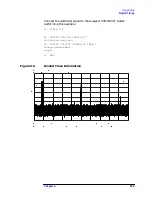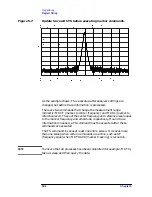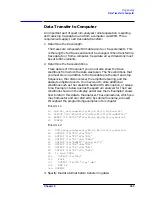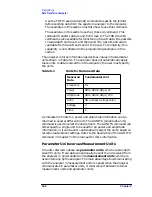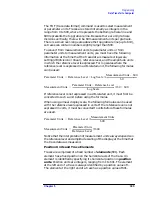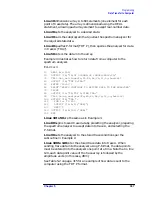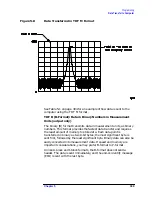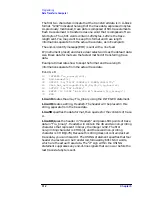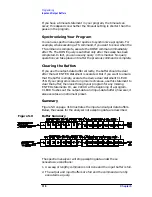
306
Chapter 5
Programming
Data Transfer to Computer
The left edge of the trace corresponds to the start frequency and the
right edge corresponds to the stop frequency. You will need to know
start and stop frequencies under which the trace data was measured if
you plan to convert from position units to frequency.
Trace-Data Formatting
The TDF (trace-data format) command controls the formatting of
trace-amplitude data. There are five format modes: real-number
parameter units (P) format, binary (B) format, A-block format, I-block
format, and measurement units (M) format. All the format modes
return amplitude information in measurement units except for TDF P,
which returns parameter units.
The output format, and how to transfer data to and from a computer
with each format, is described in the following section. TDF P: Return
Decimal Numbers in Parameter Units
The real number, or "P" format allows you to receive or send data as
ASCII decimal values in real-number (parameter) units. This is the
default format when the instrument is turned on, and when instrument
preset (IP) is activated. Numbers are in dBm, dBmV, dB
µ
V, volts, or
watts, as determined using the amplitude units (AUNITS) command.
Default units are volts for linear trace information, and dBm for
logarithmic trace information.
A line feed (ASCII code 10) follows data output. The end-or-identify
message (EOI) is sent with a line feed.
NOTE
When using the P-format, be sure to include amplitude units with the
trace data using the AUNITS command.
Real-number data can be an advantage if you wish to use the data later
in a program. However, data transfers using P-format tend to be slow
and require more storage memory (approximately 1200 bytes for binary
and 4800 bytes for real numbers). In some cases, P-format can take up
to four times the amount of controller memory compared to binary
format.
Example 3 below illustrates how to send trace data to a computer.
E
XAMPLE
3
10
REAL A(1:601)
20
OUTPUT 718;"IP;CF 300MHZ;SP 20MHZ;SNGLS;TS;"
30
CALL Get_settings(Fa,Fb,Rl,Rb,Vb,St,Lg,Aunits$)
40
OUTPUT 718;"TDF P;TRA?"
50
ENTER 718;A(*)
60
END
70
SUB Get_settings(Fa,Fb,Rl,Rb,Vb,St,Lg,Aunits$)
80
OUTPUT 718;"FA?;FB?;RL?;RB?;VB?;ST?;LG?;AUNITS?;"
90
ENTER 718 USING "K";Fa,Fb,Rl,Rb,Vb,St,Lg,Aunits$
100
SUBEND
Summary of Contents for 8560E
Page 21: ...21 1 Quick Start Guide ...
Page 48: ...48 Chapter1 Quick Start Guide Manuals Available Separately ...
Page 49: ...49 2 Making Measurements ...
Page 164: ...164 Chapter2 Making Measurements Example 13 Making Pulsed RF Measurements ...
Page 165: ...165 3 Softkey Menus ...
Page 182: ...182 Chapter3 Softkey Menus Menu Trees ...
Page 183: ...183 4 Key Function Descriptions ...
Page 228: ...228 Chapter4 Key Function Descriptions Key Descriptions Figure 4 3 CRT Alignment Pattern ...
Page 289: ...289 5 Programming ...
Page 323: ...Chapter 5 323 Programming Math Functions Figure 5 10 Display Units ...
Page 339: ...339 6 Programming Command Cross Reference ...
Page 369: ...369 7 Language Reference ...
Page 654: ...654 Chapter7 Language Reference VTL Video Trigger Level ...
Page 655: ...655 8 Options and Accessories ...
Page 665: ...665 9 If You Have a Problem ...
Page 674: ...674 Chapter9 If You Have a Problem Power Requirements Figure 9 2 AC Power Cables Available ...








